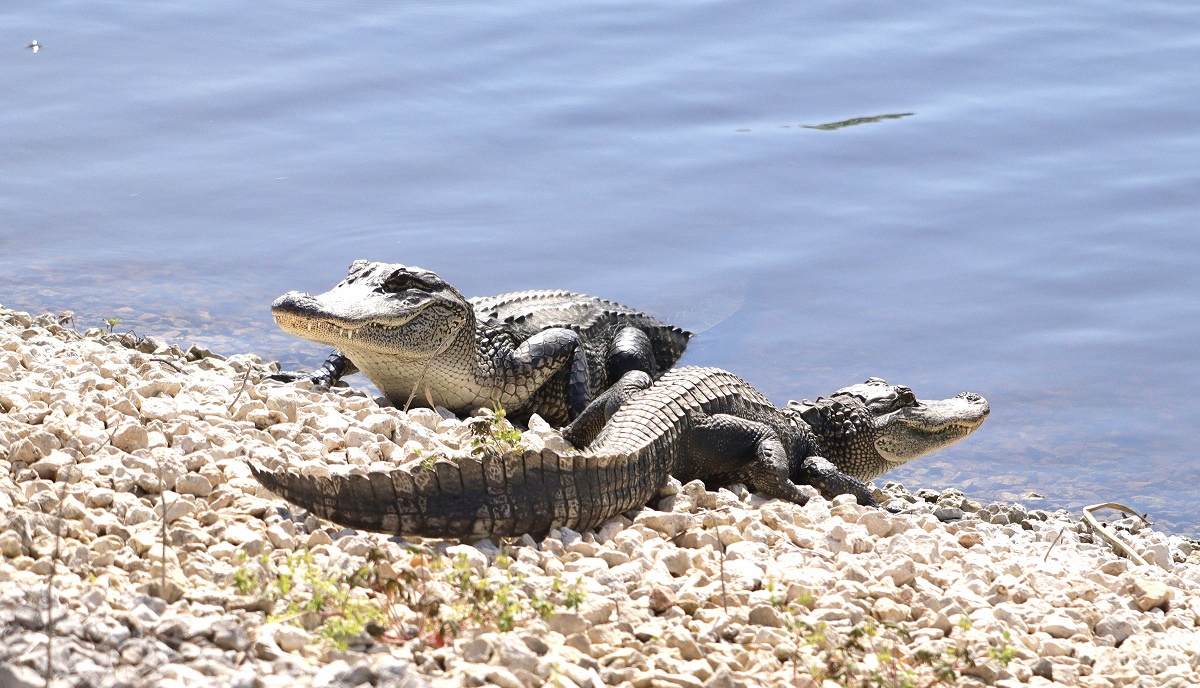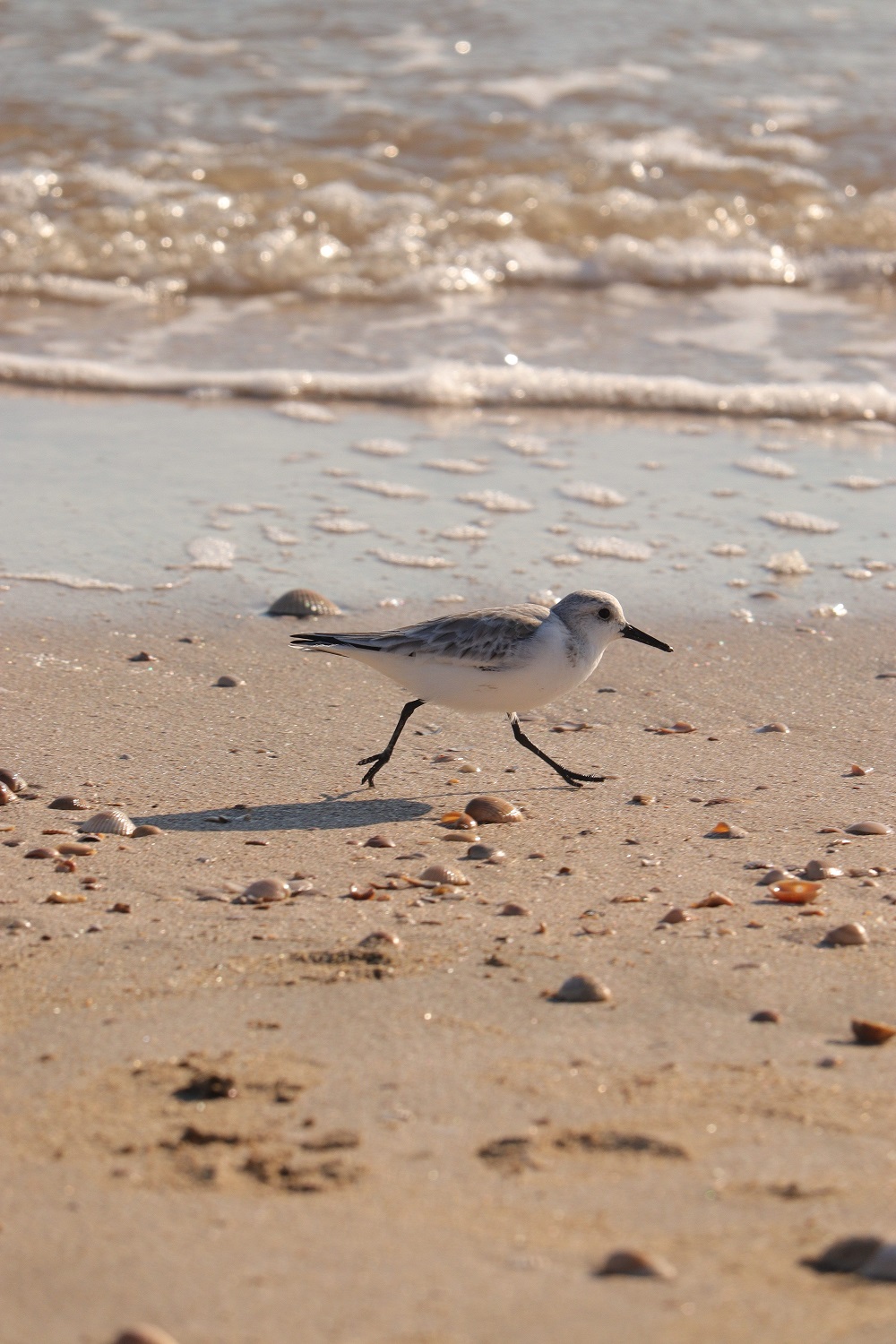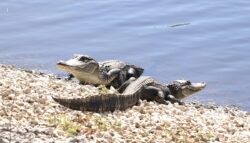Spring 2023
Pillars of Salt in the Marsh
The changing terrain of Cameron Parish
Published: February 28, 2023
Last Updated: June 1, 2023

Photo by Natalie Poole
American alligators basking in the sun on Highway 27 near the Gibbstown Bridge.
Last time I drove to the Cameron coast, I counted six dead alligators. Growing up, we’d take this road from Sweet Lake to Cameron, Creole, and Rutherford Beach often. The highway is a tiny strip of road barely above the marsh water line—no shoulder, no guard rail. I remember imagining that if our car swerved, even in the slightest, we’d slip into dark water and never come back. Alligator bait. Still today, I make a point to keep my eyes on the road, worrying that if I glance too long at the marsh, it might swallow me whole. That’s why I focus on the dead gators.
“Why did the alligator cross the road?” I ask the water lilies.
I know the answer: “To get to the other side.”
But I don’t laugh. Dad tells me that more will keep crossing, and die trying. While many people have the luxury of treating climate change as a problem of the distant future, in coastal areas like Cameron Parish, it is here now. The gators are an indicator: the marsh is too salty, or else it’s too dry, or else the drought makes the salt worse. Every explanation is true, which means no one solution will be enough. This place needs fewer storms, a more robust levee system, federal funding for the rehabilitation of marsh, more sustained attention on all the lives we stand to lose if Cameron Parish slips into the Gulf of Mexico.

Common nighthawk resting on a fence post at Rutherford Beach. Photo by Natalie Poole.
I stop at a graveyard in Oak Grove, long abandoned, caskets uprooted, headstones overturned. There I notice other victims of saltwater intrusion: entire groves of oak trees sit dead, gray and withered. That’s when I hear it. I hear what the end of the world will sound like. No birds tweet, no voices chat, no cars pass you by, even though you’re on a main highway, and it should be a busy weekday. Mangled sheet metal creaking in the wind—that’s what the end of the world sounds like. Aluminum crunched up tight and thrown into the marsh. The landscape populated by a bunch of dead alligators, and a few lingering humans who can’t bear to look away.
My dad is the one who taught me all I know about alligators. He let me skip school once on the opening day of alligator hunting season. We crisscrossed our way through Bell City to where one drainage canal meets another until it spills into the Intercoastal and then the Gulf. Had he mentioned in advance that banana spiders the size of his hand would spill onto our heads when the boat glided toward the bank, I might have opted for school that day instead.But it was important to my dad that I learn from the land just as I did inside a school—a stance embodied by Philip “Scooter” Trosclair, program manager of Rockefeller Wildlife Refuge. Situated between Grand Chenier and Pecan Island, the wildlife refuge is a swath of seventy thousand acres of marsh and coast that some call the most biologically diverse area in the nation. The area also has one of the highest rates of land loss and coastal erosion in the nation. When I asked Trosclair why he wanted such a difficult job, with so much weight on his shoulders, he shrugged off my worry, saying, “I don’t know anything else.”

Snowy plover scoping out its surroundings at Rutherford Beach. Photo by Natalie Poole.
Trosclair grew up along the banks of the Mermentau River, the son of a trapper and seafood distributor. When he turned fifteen, he started working with Rockefeller to mark alligator nests, placing him square in the middle of Cameron Parish’s greatest conservation success story. Alligators were so overhunted that they were placed on the endangered species list in the 1960s. Rockefeller led the charge to raise gators in captivity and reintroduce them to the wild.
Now, Trosclair fights the Gulf more than he tracks gators. Key “Cameron Parish” into Google Earth and you can see what I mean: from 1984 to 2020, the lakes grow larger, the coast creeps closer, the green marsh turns to brown water. In 2018 Trosclair bet on a rock breakwater project that aims to decrease the wave energy eroding the shoreline. But as of late 2022 only four of Rockefeller’s twenty-seven miles of coastline are protected, and each additional mile comes with a $10 million price tag.
What is too often considered a “shoreline” problem is everyone’s problem, really. A creeping coastline alters habitats further inland, and because the coast is closer now to the marsh, Trosclair explained, saltwater enters the marsh quicker and drains slower. The saltier the marsh, the harder for vegetation to survive. Marsh then turns into open water, which means less biodiversity, with fewer species that can thrive.
Duck hunters know this problem well. Last winter, the number of pintails, green heads, blue-winged teal, and other ducks who visited the parish were almost the lowest on record. Reports among local hunters are that banded ducks fly into Cameron Parish and return to Arkansas the same day, because there is not enough vegetation for feeding. Ducks, at least, can fly away and find a suitable home elsewhere. Alligators, fish, and marsh grasses have no choice but to grow sick and perish.
What many in conservation hint at, but won’t say, is that this saltwater issue comes from the Calcasieu Ship Channel, which means from the oil and gas industry, which means we chose petroleum over pelicans. When I said as much to Trosclair, he nodded and smiled, but quickly tried to change my tune. Oil and gas, he maintained, has done more to protect our parish than contaminate it.Rockefeller, after all, is named after a well-known oil tycoon. And inequities of state and federal funding result in the parish relying instead on industry-funded mitigation projects that seek to stabilize the land’s oil and gas resources to protect its marsh and coast. Take, for example, a project to restore four hundred acres of marsh in Hackberry, funded by a nearly $14 million settlement following a CITGO oil spill. The project widens the Calcasieu Ship Channel, but places the dredged sediment into open water areas to encourage vegetation growth and rebuild marsh.

A moon snail shell stranded in the sand during low tide at Rutherford Beach. Photo by Natalie Poole.
As someone who grew up next to a field that served as a toxic dump site, I struggle with the contradictions of oil and gas, which extend well beyond mitigation efforts. The state-funded scholarships that sent me to college might have not existed without industry, and yet, without industry, maybe my grandparents who lived there would not have battled such obscure cancers. And my story is not unique. So, whether oil and gas have done more harm than good is not a conversation many down there are willing to have—especially given that, at least according to one late-2021 report, the ship channel accounts for two-thirds of the area’s economy.
That’s why, when I talk about Cameron Parish with my friends, I’m always searching for allies who will help me point a finger to extractive industry. I want someone else to affirm that we are not to blame for this parish’s predicament, that systems larger, stronger, and richer than us decided what would become of this place. They agree, but we all stumble over solutions—what idea would work, much less make things right. We tend to arrive at one main conclusion: “This place humbles you.” Quiet usually then lingers between us—we’re all wondering what happens should this place go to the birds, or what’s left of them.
Shore birds nesting along Rutherford and Holly Beach pen a different narrative for the parish, one that hints at hope. Snowy plovers and black skimmers have hatched and raised chicks for the first time in nearly a decade along the Cameron coast; the hurricanes of recent years washed sand into nearby pastures, extended their nesting sites, and decreased the presence of predators like coyotes and crabs who threaten their young. Biologists Erik Johnson and Katie Barnes of Audubon Delta are the ones responsible for protecting shore birds along southwest Louisiana’s coast and ensuring their recent success through sand renourishment projects that heighten shore elevation and improve the area’s overall habitat. When I hear that these birds prosper despite disaster, it’s hard not to see parallels between the birds and the folks I know back home.
Struck by two major hurricanes, a previously decimated dune system on Rutherford Beach is now thriving thanks to fencing and signs protecting the sensitive habitat that were installed by Audubon Delta, National Audubon Society. Photo by Natalie Poole.
The Wilson’s plover is short and stocky with a bill oddly large for its size—but necessary, because these birds go after game bigger and mightier than it seems they should. Small and underestimated, but packing a punch—reminds me of my grandpa, who started with nothing and built a successful business. The least tern is small, too, but elegant. Its voice is unmistakable, piercing the air with power, and when it feeds, the bird hovers over the water before exacting a quick, decisive strike. Sharp, confident, and charmingly obnoxious—that sounds like my cousin who used to take me driving during tropical storms so we could feel the rain sting our faces.
Or watch the black skimmer, which is a bit funny looking with its uneven bill, but which has a certain way about it. Skimmers don’t look for food but rather feel their way to it, tracing their bill through the water until something resonates. I see a little of this bird in all of us down there: trusting in what we can’t yet see.
The persistent success of shore birds paired with the decreasing presence of waterfowl in the parish tells of a reality that Johnson knows well: there will always be a shore, but there may not always be a marsh. When I asked where he finds hope to continue his work, grappling with forces as mighty as the Gulf, Johnson pointed to the birds. He watches them raise their young in a dissolving coast and thinks, “If they can do it, we can do it.”
As Johnson spoke, I recognized a fear I had never quite been able to name. I’m a young, married woman from a large family, but I no longer live in Cameron Parish, and I struggle with the idea of having kids. Some of that struggle has to do with broad concerns regarding climate change and the future of our planet. But it’s more specific, I now realize. It’s that I don’t know what it means to raise a child if not on this land. Is becoming who you are not whispered by the cattails in the marsh? Is it not written in the sky through the strokes of the whooping crane? Is learning to be tough not a lesson from the shore birds, about the need to accept disaster and adapt? I trust no other land, no other wildlife, with lessons on how to be and become in this world.

Sanderling chasing the waves in search of a meal at Broussard Beach. Photo by Natalie Poole.
We alter rivers and withdraw resources primarily for oil and gas. Which is another way of saying: whenever Cameron Parish sinks into the Gulf of Mexico, natural climate cycles will not be to blame, but our willingness to rip apart an already delicate, lacy coast.
Some days I think we’ll turn out like the skimmers and plovers—we’ll keep thriving off disaster, man-made or otherwise. We’ll keep hoping and rebuilding. We’ll keep raising our young to be gritty and resilient.

An American alligator begins to hunt as the sun sets in the Cameron Prairie National Wildlife Refuge. Photo by Natalie Poole.
Other days, though, when I’m standing in the middle of Highway 27, tasting the air for sea salt, which shouldn’t be this far inland, I worry that we’ll become a modern-day apocalyptic warning, one they’ll pass down through the ages. “Remember Cameron Parish,” they’ll say, just like Christ once told his disciples: “Remember Lot’s wife.” Standing there, listening to sheet metal moan, I wonder what it would mean if I turned into a pillar of salt, right here in the marsh.
Most remember that story from the book of Genesis, but when Christ tells the story centuries later, he marks disaster in Lot’s time because people were busy “buying and selling, planting and building.” The need for more—that’s why sulfur, a common pollutant of the oil and gas industry, rained down from the heavens.
Yet for all the trouble of the place, Lot’s wife couldn’t convince herself to turn away. She wanted to believe that the place could still be redeemed, the land still returned to its splendor. Geologists claim to have found her along the banks of the Dead Sea.
Not much grows in the Dead Sea, little wildlife visits, and both Lot’s wife and her home are preserved, frozen in hope that salt and sulfur won’t get the final word. I bet she worried that turning away would leave her only with memories of the home she knew. If that’s what happens to those who can’t look away from the land that made them, consider me a pillar of salt.
Megan Poole was born and raised in Grand Lake, a small town south of Lake Charles, Louisiana. She is an assistant professor of English at the University of Louisville where she specializes in rhetoric.
